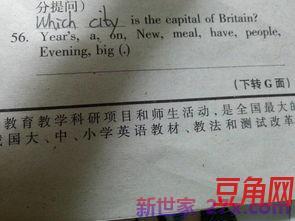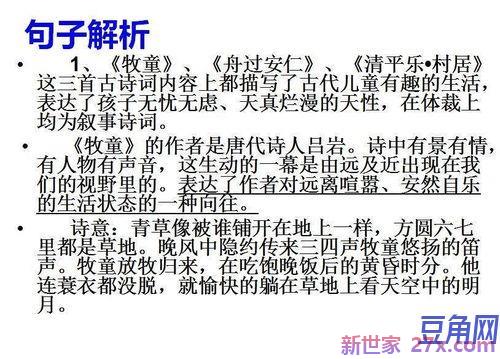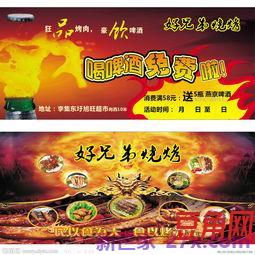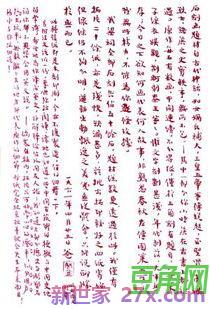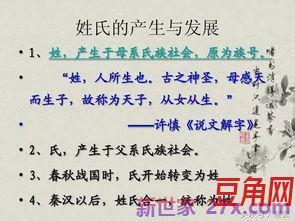|
微信分身24小时自助商城:
微信分身24小时自助商场:
微信分身24小时自助商场: |
1.小学六年级英语句型
给你总结的也有语法重点也有一些句型结合希望对你有帮助! 陈述句的故事 Hello, boys and girls!大家都知道,陈述句家族的职责是用来叙述一个事实。
其特点是句末用句号".",朗读时通常用降调"↘"。 陈述句家族中有"两兄弟":老大是肯定句,老二是否定句。
老大肯定句,对人对事都持有肯定的态度,常说的三句话是: 1.I am Tom .我是汤姆。〔系动词be型〕 2.I have an apple.我有一个苹果。
〔have/has(有)动词型〕 3.I like playing football.我喜欢踢足球。〔实义动词型〕 4.I can cook the meals.我会做菜。
〔情态动词型〕 老二否定句,对人对事总是持有否定的态度,和大哥肯定句唱反调。老二常把大哥的话加上"不"字,不信,请听: 1.I am not Tom.我不是汤姆。
2.I have not an apple.我没有苹果。 3.I don't like playing football.我不喜欢踢足球。
4.I can't cook the meals.我不会做菜. 小朋友们,现在你们对这"两兄弟"有所了解了吧!但是关于这"两兄弟"的学问还有许多,在今后的学习中,你们与它们还会见面,所以在平时的学习中要多留意哟。 练习改错: 1、I'm is a student. 2、He is go to school at 7:00. 3、I can playing football. 一般疑问句 1. 概念 能用yes / no(或相当于yes / no)回答的问句叫一般疑问句。
2. 含系动词be的一般疑问句的构成 具体地说,就是当陈述句中有am /is / are时,可直接将它们提至主语前,但如遇第一人称,最好将其置换成第二人称。如: I'm in Class 2, Grade 1. →Are you in Class 2, Grade 1? 你是在一年级二班吗? 3. 含情态动词的一般疑问句的构成 一般疑问句面前人人平等:情态动词与am / is / are一样,也可直接将它们提至主语前,所以问题迎刃而解了。
如: I can spell it. →Can you spell it? 你会拼写它吗? 4. 含实义动词的一般疑问句的构成 含实义动词的一般疑问句的构成稍微有点讲究,要在句首加do;如逢主语为第三人称单数,谓语动词为一般现在时单数第三人称形式"v-(e)s"时,奉does为座上宾并要变回原形(如has→have,likes→like等);有时陈述句中的some还要变作any等。如: She lives in Beijing. →Does she live in Beijing? 她住在北京吗? I like English. →Do you like English? 你喜欢英语吗? There are some books on my desk.→Are there any books on your desk? 5. 少数口语化的一般疑问句 如问一个与前文相同的问句时,可省略成"And you?"或"What / How about。
"等;甚至只抓关键词,读作升调。如:Your pen? 你的钢笔? 6. 小插曲:一般疑问句的语调 大部分的一般疑问句都应读作升调(↗),并落在最后一个单词身上。
如:Is it a Chinese car↗? 7. 一般疑问句的应答 用yes / no(或相当于yes / no的词)回答,并怎么问怎么答(句首为情态动词am / is / are还是do /does),简略回答时要注意缩写(否定的n't)和采用相应的人称代词以避免重复:即"Yes,主语(代词)+情态动词或am / is / are或do / does."表示肯定;"No,主语(代词)+情态动词或am / is / are或者do / does not(n't)."表示否定。如: ① -Is Mary a Japanese girl? 玛丽是日本女孩吗? -Yes, she is. / No, she isn't. 是的,她是。
/不,她不是。 ② -Can Lily speak Chinese? 莉莉会说中国话吗? -No, she can't. / Sorry, I don't know. 不,她不会。
/对不起,我不知道。 ③ -Do you like English? 你喜欢英语吗? -Yes, very much. 是的,非常喜欢。
how 疑问句一家子的“实话实说” 【王小元】各位观众,大家好!我是英语栏目的主持人王小元。今天,我非常荣幸地请到了how疑问句一家子。
有请几位上台! (how携how much, how often 等上台。) 【王小元】how先生,请您给大家做一下自我介绍好吗? 【how】I am too excited to say a word. 【王小元】how先生,别激动。
Take it easy. 【how】各位观众,大家好!我叫how, 我主要用来引导特殊疑问句,可以询问身体健康。如: How is your mother today? 你妈妈今天身体好吗? 我还可以询问交通方式。
如: How does Li Lei usually go to school? 李雷通常怎样去学校? 另外我也可以询问天气。如: How is the weather today? 今天天气怎么样? That's all. Thank you. 【王小元】感谢how先生所做的精彩介绍。
大家知道,how后面跟不同的形容词或副词,同样可以引导含义不同的特殊疑问句,如how old, how long, how often 等。下面就请各位踊跃发言。
【how old】我主要用来询问年龄。如: How old is Mr Wang? 王先生多大年龄? 当然,我也可以用来询问建筑物的年头、历史等。
如: How old is this bridge? 这座桥有多少年的历史了? 【how long】我多用来询问长度。如: How long is the Yellow River? 黄河有多长? 【how often】how long, 你怎么不实说实话呢?你忘了你还能询问时间长短呢!如: How long does it take you to go to work by bike every day? 你每天骑自行车上班花多长时间? 【how long】您瞧我这记性。
Mr Wang, I am sorry. 【王小元】That's all right. how often先生,请你介绍一下自己好吗? 【how often】我没。
2.六年级英语、给所给的单词组成句子
We begin to plant trees about at the nine.
We put the young trees into the hole.
We hole us will grow the all trees of well.
We helped them water the flowers.
Why did they plant the trees?
:Hi,Ben!(What)were you yesterday!
b:I( was )at home.
a:( What )did you do at home?
b:I(did )my homework and (watched )TV.What(about )you?
a:I worked on the farm ( with )my classmates.
b:What( did)you do there,liming?
a:We planted fruit trees.
b:To( Plant )trees is much funnier ( than )to do homework,I think.
3.英语六大基本句型结构
1,主语+谓语
2,主语+谓语+宾语
3,主语+谓语+宾语+宾语补足语
4,主语+系动词谓语+表语
5,主语+谓语+间接宾语+直接宾语
6,主语+谓语+直接宾语+for/to间接宾语。
4.求六年级到初二英语的所有句型结构
第一类:be(“是/存在”)动词的各种时态结构: 一 般 现 在 时 I am…. You are.… He/She/It is…. We/You/They are…. 一 般 将 来 时 (1)(I等各人称) will be…. (2)I am going to be… He/She/It is going to be… We/You/They are going to be… 现 在 完 成 时 I have been…. You have been…. She/he/It has been…. We/You/They have been…. 一 般 过 去 时 I was…. You were.… He/She/It was…. We/You/They were…. 过 去 将 来 时 (1)(I等各人称) would be…. (2)I was going to be… He/She/It was going to be… We/You/They were going to be… 过 去 完 成 时 I had been…. You had been…. She/he/It had been…. We/You/They had been…. 第二类:行为动词的各种时态结构: 一 般 现 在 时 动词用原形(单三人称动词加s / es) (问句和否定句借用助词do / does) 一 般 过 去 时 动词用过去式 (问句和否定句借用助词did) 现 在 进 行 时 am +动词-ing is +动词-ing are +动词-ing 过 去 进 行 时 was +动词-ing were +动词-ing 一 般 将 来 时 (1)will + 动词原形 (2)am +going to+动词原形 Is +going to+动词原形 are +going to+动词原形 过 去 将 来 时 (1)would + 动词原形 (2)was +going to+动词原形 were +going to+动词原形 现 在 完 成 时 have +过去分词 has +过去分词 过 去 完 成 时 had +过去分词。
5.50分 英语句子的结构
英语句子主要有五大种,
1主语+谓语:I see. 主语加上动作
2主谓宾:he eats some food. 主语加上动作加上物品
3主系表:he is a boy. be 动词和助动词就叫系动词 主语加上be加上后面的,后面的东西就叫表语
4主谓宾补:he eats some food fast. 主语加上动作加上物品再加上程度(fast)
5主谓双宾【直接宾语,间接宾语}:he gave her a pen. 主语加上动词加上对象再加上东西 give这个词最典型的用法
主语就是句子所陈述的对象,谓语就是主语发出的或接受的动作,宾语是动作作用的对象,定语一定修饰名词,通常一个句子中在名词前面的形容词就是定语了。状语一定修饰动词,但是位置可前可后;补语是修饰的整个句子,在一句话的末尾;不及物动词是后面不能加宾语,比如cry,我哭了就是I cry 后面不能在加东西;及物后面必须接宾语,如eat 我吃了些东西I eat some food。不能只说我吃,必须加上吃什么(food)
举个例子 I study Enlish very hard.
6.英语句子结构
组成句子的六大句子成份是、主语、谓语、宾语、定语、状语、补语。
构成英语句子的18种句子零件: *根零件1:主 + 谓 + [宾] *根零件2:主 + 系 + 表 *根零件3:there + be +零件4(名词短语) *零件4(名词短语): n[adj(形容词)+n,n+n,n+of+n,n`s n,the+adj,,,,,,,],n代表名词,[]里面的是名词短语的组合类型。 #n:表示单个名词,如dog、he、she、life、love、myself等. #adj + n:形容词加名词组合,如: good plan、easy job、betterr dog等. #n + n:名词加名词组合,如: English book、sun light、human beging 、computer network等. #n of n:of n是前n的大定语,如: the name of the boy. #the +adj: 表达具有adj特性的所有东西,如:the old(老人)、the young(年轻人)*零件5(形容词短语): adj [adj-er,adj-est,adv + adj,名词组+adj,。
] adj代形容词、adv代表副词、这个零件是以形容词为核心.。 #adj、adj-er、adj-est分别表示单个形容词,如: good、better、best. #adv + adj,副词加形容词,如:very good. #名词组+adj,如:two years old、there meters long *零件6(副词短语): adv[adv-er,adv-est,adv+adv,名词组+adv],副词组。
#adv单个副词,如:ever、always,about,suddenly、finally. #adv+adv,副词加副词,如:pretty soon、very much、very well. #名词组+adv,如:three years ago、two days later. 名词用做副词:today、tonight、now. *零件7(介词短语): 介词+零件4、介词+零件10、介词+零件13: #介词+零件4,如:in the school.at that moment、by the time. #介词+零件10,如:in studying English、by changing the color, #介词+零件13,如:they are talking about who will come today. *零件8(谓语动词短语): 将来助动词、完成助动词、动词(V)+(介词)构成谓语短语零件8. #单个动词如:like、study. #动词+介词:talk to,break out、call on,run into、get up、give up、take off *非谓语动词短语零件9(to v定式短语): 如:to go、to finish the work. *非谓语动词短语零件10( v-ing定式短语): 如:running 、speaking、going, *非谓语动词短语零件11(v-ed定式短语): 如:the device used by him,the students arranged to go to school. *从句零件12-17 从主从连接词+块1-3、宾从连接词+块1-3、补从连接词+块1-3、表从连接词+块1-3、定从连接词+块1-3、状从连接词+块1-3. *零件18(残句零件) 如:Thank you、see you later、be quiet. 【总结】 18个句子零件、是担当6大句子成分的具体材料.三大根零件,形成句子基本框架.! 18个零件中能做主语的零件: #用零件4(名词短语做主语) 如:This house has many lights、he wanted to move his house, #用零件9(to v做主语) 如:to stop the work is impossible 、to see is to believe. #用零件10( v-ing做主语) 如:Smoking is bad to health、Speaking is easier than doing. #用零件12(主语从句做主语) 如:that she is still alive is agood thing、that you are coming to visit us is the best news for us. 18个零件中能做谓语的零件: 谓语就是三大基本句型:主谓宾、主系表、there be.只不过谓语拥有很多时态的变化。 18个零件中能做宾语的零件: #用零件4(名词短语做宾语) 如:i have afew friends(我有几个朋友)、we lost our way. #用零件9(to v短语作宾语) 如:i decided to go to shanghai. #用零件10( v-ing短语作宾语) 如:i enjoy listening to the music, #用零件13(宾语从句作宾语) 如:I believe that he is telling the truth. 18个零件中能做补语的零件: #用零件4 (名词短语作补语) i offered my friend a cup of coffee #用零件5(形容词短语作补语) we found him ill、she seemed quite happy. #用零件7(介词短语快) we found him in trouble, #用零件9(to-v) i have homework to do, #用零件10(v-ing 短语块) we saw him playing the music. #用零件11(v-ed) he looked so determined #用零件14(补从) I am sure he will come. 18个零件中能做表语的零件: #用零件4(名词短语) the book is an english book , #用零件5(形容词短语) i am glad, #用零件7(介词短语) the ball is in he box, #用零件9(to -v) her job is to wash clothes #用零件10(v-ing) my hobby is listening to music #用零件15(表语从句) the trouble is that i have lost the address. 18个零件中能做定语的零件: #用零件4(名词短语) the air conditioner works well #用零件5(形容词短语块) it is a small tonw #用零件7(介词短语块) people in beijing #用零件9(to -v) the way to do work #用零件10(v-ing) the person speaking english #用零件11(v-ed) a cat named teddy #用零件16(定语从句) tell us all things(that) you known 18个零件中能做状语的零件: 动词的时间、地点、原因、状态、目的、结果、方式、程度, #用零件6(副词短语) i quickly promised #用零件7(介词短语) she looks like an actress #用零件9(to-v) i went to post-office to mail a letter #用零件10(v-ing) being sick,i stayed at home, #用零件11(v-ed) united,we stand;pided,we fall. #用零件17(状语从句) i waved 。
7.六年级下册英语句子表
1.--- How tall are you?
--- I'm 164 cm tall.
2.You are shorter than me.
3.You're 4 cm taller than me.
4.--- How heavy are you?
--- I'm 48 kg.
5.I'm thinner than you,and shorter.
6.--- What's the matter with you?
--- My throat is sore./ My nose hurts.
7.--- How do you feel?
--- I feel sick.
8.How are you,Liu Yun?You look so happy.
9.How are you,Sarah?You look sad today.
10.--- What did you do last weekend?
--- I played football.
11.--- Did you help them clean their room?
--- Yes,I did.
12.--- What did you do yesterday?
--- I went fishing.
8.英语句子的结构
英语的句子有6种基本结构。
1.主语+系动词+表语(A is B.)
[例句]
哈佛是最早接受中国留学生的美国大学之一。
Harvard is among the first American universities to accept Chinese students.
2.主语+及物动词+宾语(A does B.)
[例句]
这些传统,对今天中国人的价值观念、生活方式和中国的发展道路,具有深刻的影响。
These traditions have exerted a profound impact on the values and way of life of the Chinese people, and on China's road of development today.
3.主语+不及物动词(A leaves.)
[例句]
1847年,中国最早的一批留美学生容闳等人赴美求学。
In 1847, Chinese student Rong Hong and others came to the United States as the first group of Chinese students to study here.
4.主语+及物动词+双宾语(间接宾语指人,直接宾语指物)(A gives B something.)
[例句]
昨天,我参观了国际商用机器公司、美国电话电报公司和贝尔实验室,领略了当代科技发展的前沿成就。
My visit to IBM, AT&T and the Bell laboratory yesterday gave me some first-hand knowledge of the latest successes in modern science and technology.
5.主语+及物动词+复合宾语(即宾语+宾语补足语)(A tells B to do something)
[例句]
今天,正在为实现现代化而奋斗的中国人民,把对外开放作为一项基本国策。
Today, the Chinese people who are struggling to achieve modernization have made the opening-up a basic state policy.
6.There+系动词+主语(There is a man.)
[例句]
在自由市场经济国家企业类型有多种多样。
There are many types of businesses in a free-market economy.
| 声明:本文内容及图片来源于读者投稿,本网站无法甄别是否为投稿用户创作以及文章的准确性,本站尊重并保护知识产权,根据《信息网络传播权保护条例》,如果我们转载的作品侵犯了您的权利,请在一个月内通知我们,我们会及时删除。请将本侵权页面网址发送邮件到35210957@qq.com,我们会及时做删除处理。 |




